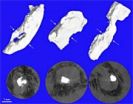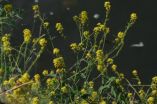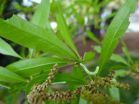(Press-News.org) One week after the official start of hurricane season in the Eastern Pacific Ocean, the first tropical depression was born hundreds of miles southwest of Mexico. NASA's TRMM satellite and NOAA's GOES-West satellites provided looks inside and outside of the depression's clouds. Hurricane season in the Eastern Pacific began officially on May 15.
On May 21 at 22:59 UTC (6:59 p.m. EDT) the Tropical Rainfall Measuring Mission (TRMM) satellite passed over System 92E, which was what Tropical Depression 1E (TD1E) was called before it organized into a depression. TRMM's Precipitation Radar (PR) data were used to create a 3-D view of System 92E's rainfall structure and revealed a few strong thunderstorms reached altitudes of 16.5 km (about 10.2 miles). These tall thunderstorms are often a sign that a tropical cyclone is forming or strengthening. Within twenty-four hours
TD1E consolidated into a depression around 2 p.m. PDT (5 p.m. EDT) on May 22. At that time it was centered near 10.3 north latitude and 107.4 west longitude or about 635 miles (1,020 km) south-southwest of Manzanillo Mexico and had maximum sustained winds near 30 mph (45 kph).
Today, May 23, the depression continued to strengthen and maximum sustained winds increased to 35 mph (55 kph). The National Hurricane Center (NHC) expects the depression to become a tropical storm later today. At 0900 UTC (2 a.m. EDT) TD1E was located about 625 miles (1, 005 km) south-southwest of Manzanillo, Mexico near 10.8 north latitude and 108.2 west longitude. TD1E is moving to the west-northwest at 5 mph (7 kph) and has a minimum central pressure of 1006 millibars.
Forecaster Beven at NHC noted that "Convective banding is currently increasing near the center of Tropical Depression One-E over the northern semicircle. The depression is currently expected to be in an area of light/moderate southerly vertical wind shear during the forecast period. This should allow at least gradual strengthening."
The National Hurricane Center expects TD1E to move slowly toward the west-northwest or west is expected for the next couple of days.
INFORMATION:
Rob Gutro
NASA's Goddard Space Flight Center
NASA sees first tropical depression of Eastern Pacific hurricane season
2014-05-23
ELSE PRESS RELEASES FROM THIS DATE:
Supernova caught in the act by palomar transient factory
2014-05-23
Supernovae—stellar explosions—are incredibly energetic, dynamic events. It is easy to imagine that they are uncommon, but the universe is a big place and supernovae are actually fairly routine. The problem with observing supernovae is knowing just when and where one is occurring and being able to point a world-class telescope at it in the hours immediately afterward, when precious data about the supernova's progenitor star is available. Fortunately the intermediate Palomar Transient Factory (iPTF) operated by Caltech scans the sky constantly in search of dramatic astrophysical ...
Mapping atherosclerotic arteries: Combined approach developed
2014-05-23
A new method allows calcified and constricted blood vessels to be visualized with micrometer precision, and can be used to design containers for targeted drug delivery. Within the project "NO-stress", materials scientists from the Medical Faculty of the University of Basel combined cutting-edge-imaging techniques to visualize and quantify the constrictions caused by atherosclerosis.
Cardiovascular diseases, including atherosclerosis, are associated with plaque formation and the most prevalent cause of death worldwide. Unlike vessels and other soft tissues, the plaque ...
Risk is much more than a game
2014-05-23
Wildfires and flooding affect many more people in the USA than earthquakes and landslide and yet the dread, the perceived risk, of the latter two is much greater than for those hazards that are more frequent and cause greater loss of life. Research published in the International Journal of Risk Assessment and Management, suggests that a new paradigm for risk assessment is needed so that mitigation plans in the face of natural disasters can be framed appropriately by policy makers and those in the emergency services.
Maura Knutson (nee Hurley) and Ross Corotis of the University ...
The protective milk shot
2014-05-23
Antibodies against C. suis are transferred via the sow's very first milk to the piglets immediately after birth. This was discovered by veterinarian and parasitologist Lukas Schwarz and his colleagues in 2013. These findings prompted the researchers at the Institute for Parasitology to look for a way to increase the level of these antibodies in sows. The ultimate goal was to provide the piglets with as much antibodies as possible via their mother's milk during the first few days of life.
Piglets from infected mothers are healthier
The idea paid off. Piglets from infected ...
Nature inspires drones of the future
2014-05-23
Researchers have been taking tips from nature to build the next generation of flying robots.
Based on the mechanisms adopted by birds, bats, insects and snakes, 14 distinguished research teams have developed solutions to some of the common problems that drones could be faced with when navigating through an urban environment and performing novel tasks for the benefit of society.
Whether this is avoiding obstacles, picking up and delivering items or improving the take-off and landing on tricky surfaces, it is hoped the solutions can lead to the deployment of drones in ...
Rapid evolution aids spread of exotic plant species
2014-05-23
A team of Belgian biologists led by researchers at KU Leuven has provided the first genetic evidence that rapid evolution can help non-native plant species spread in new environments. Using samples of centuries-old herbaria and DNA analysis, the researchers reconstructed the genetic adaptations undergone by the Pyrenean rocket prior to its rapid spread in Belgium.
The Pyrenean rocket (Sisymbrium austriacum subsp. chrysanthum) is a plant that grows in the mountains of southern Europe and is particularly prevalent in the Pyrenees. The species was first reported in Belgium ...
Lack of plant diversity spurs cankerworm damage in cities
2014-05-23
Research from North Carolina State University finds that a lack of plant diversity is a key contributor to the widespread defoliation caused by cankerworms in cities, and highlights the role that increasing diversity can play in limiting future damage.
Fall cankerworms (Alsophila pometaria) are caterpillars that are native to the eastern United States and hatch in early spring. The cankerworms defoliate trees and other plants, eating new leaves as they emerge – which is both unsightly and can ultimately kill the plants.
"We see cankerworms doing more damage to trees ...
Flatland optics with graphene
2014-05-23
Researchers from CIC nanoGUNE, in collaboration with ICFO and Graphenea, introduce a platform technology based on optical antennas for trapping and controlling light with the one-atom-thick material graphene. The experiments show that the dramatically squeezed graphene-guided light can be focused and bent, following the fundamental principles of conventional optics. The work, published yesterday in Science, opens new opportunities for smaller and faster photonic devices and circuits.
Optical circuits and devices could make signal processing and computing much faster. ...
Bacterial adaptation contributes to pneumococcal threat in sickle cell disease patients
2014-05-23
Researchers have identified differences in the genetic code of pneumococcal bacteria that may explain why it poses such a risk to children with sickle cell disease and why current vaccines don't provide better protection against the infection. St. Jude Children's Research Hospital scientists led the study, which appeared earlier this month in the journal Cell Host & Microbe.
The findings will aid efforts to improve vaccine effectiveness and inform research into new ways to protect young sickle cell disease patients from life-threatening pneumococcal infections that can ...
Breakthrough in RSV research to help infected children
2014-05-23
Researchers at Le Bonheur Children's Hospital and the University of Tennessee Health Science Center announced results today from a clinical trial of a drug shown to safely reduce the viral load and clinical illness of healthy adult volunteers intranasally infected with respiratory syncytial virus (RSV).
Detailed results of this study were presented by lead researcher Infectious Disease Specialist John DeVincenzo, MD, this week during a poster discussion session at the American Thoracic Society 2014 International Conference in San Diego. He serves as medical director of ...






